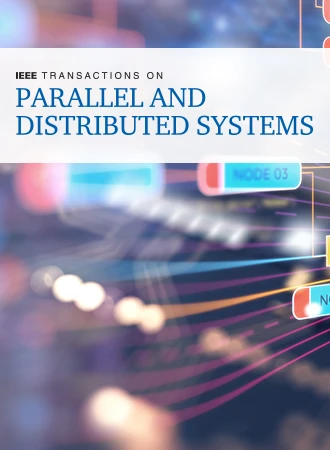异构处理器上具有通信延迟和等处理时间的分叉连接调度
IF 6
2区 计算机科学
Q1 COMPUTER SCIENCE, THEORY & METHODS
IEEE Transactions on Parallel and Distributed Systems
Pub Date : 2025-09-02
DOI:10.1109/TPDS.2025.3605272
引用次数: 0
摘要
并行计算的任务调度即使没有优先约束也是强NP-hard的。由于任何类型的优先级限制和通信延迟,问题变得更加难以管理。我们研究了在fork-join结构的优先级约束下(包括通信延迟)调度的具体情况$P[Q]|fork-join, c_{ij}| c_{\max}$。这表示任何一种划分为子计算并将最终结果一起处理的计算。考虑到计算成本相等的特殊情况,我们提出多项式时间近似值和精确算法,考虑同质和(相关的)异构处理器。有了这些算法,我们就可以在大型实验评估中研究启发式的质量。这表明启发式调度器在大多数情况下执行得足够好。本文章由计算机程序翻译,如有差异,请以英文原文为准。
Scheduling Fork-Joins With Communication Delays and Equal Processing Times on Heterogeneous Processors
Task scheduling for parallel computing is strongly NP-hard even without precedence constraints $P||C_{\max}$ $P[Q]|fork-join, c_{ij}|C_{\max}$
求助全文
通过发布文献求助,成功后即可免费获取论文全文。
去求助
来源期刊

IEEE Transactions on Parallel and Distributed Systems
工程技术-工程:电子与电气
CiteScore
11.00
自引率
9.40%
发文量
281
审稿时长
5.6 months
期刊介绍:
IEEE Transactions on Parallel and Distributed Systems (TPDS) is published monthly. It publishes a range of papers, comments on previously published papers, and survey articles that deal with the parallel and distributed systems research areas of current importance to our readers. Particular areas of interest include, but are not limited to:
a) Parallel and distributed algorithms, focusing on topics such as: models of computation; numerical, combinatorial, and data-intensive parallel algorithms, scalability of algorithms and data structures for parallel and distributed systems, communication and synchronization protocols, network algorithms, scheduling, and load balancing.
b) Applications of parallel and distributed computing, including computational and data-enabled science and engineering, big data applications, parallel crowd sourcing, large-scale social network analysis, management of big data, cloud and grid computing, scientific and biomedical applications, mobile computing, and cyber-physical systems.
c) Parallel and distributed architectures, including architectures for instruction-level and thread-level parallelism; design, analysis, implementation, fault resilience and performance measurements of multiple-processor systems; multicore processors, heterogeneous many-core systems; petascale and exascale systems designs; novel big data architectures; special purpose architectures, including graphics processors, signal processors, network processors, media accelerators, and other special purpose processors and accelerators; impact of technology on architecture; network and interconnect architectures; parallel I/O and storage systems; architecture of the memory hierarchy; power-efficient and green computing architectures; dependable architectures; and performance modeling and evaluation.
d) Parallel and distributed software, including parallel and multicore programming languages and compilers, runtime systems, operating systems, Internet computing and web services, resource management including green computing, middleware for grids, clouds, and data centers, libraries, performance modeling and evaluation, parallel programming paradigms, and programming environments and tools.
 求助内容:
求助内容: 应助结果提醒方式:
应助结果提醒方式:


